
MAY CONTAIN NUTS

Search Shorpy
SHORPY ART

Framed or unframed, desk size to sofa size, printed by us in Arizona and Alabama since 2007. Explore now.
Join and Share
Ad-Free Shorpy
Shorpy is funded by you. Patreon contributors get an ad-free experience.
Learn more.

Recent comments
- Texas Flyer wanted
- Just a Year Too Soon
- WWII -- Replacing men with women at the railroad crossing.
- Yes, Icing
- You kids drive me nuts!
- NOT An Easy Job
- I wonder
- Just add window boxes
- Icing Platform?
- Indiana Harbor Belt abides
- Freezing haze
- Corrections (for those who care)
- C&NW at Nelson
- Fallen Flags
- A dangerous job made worse
- Water Stop
- Passenger trains have right of way over freights?
- Coal
- Never ceases to amaze me.
- Still chuggin' (in model form)
- Great shot
- Westerly Breeze
- For the men, a trapeze
- Tickled
- Sense of loneliness ...
- 2 cents
- Charm City
- What an Outrage
- Brighton Park
- Catenary Supports
Member Photos
The Shorpy
Print Emporium
Print Emporium
Search Shorpy
Search results -- 30 results per page
- Landing Party: 1905
- ... taking place?
Landlocked Not growing up near an ocean, could someone explain the roped-in purpose? Was that a safe zone? Were some ocean days more dangerous to swimmer's than others? Thanks!
[The ropes ... Posted by Dave - 10/22/2016 - 1:30pm -
![Landing Party: 1905 The Jersey Shore circa 1905. "In the surf at Asbury Park." Having a wonderful time; wish we were still here. 8x10 inch dry plate glass negative. View full size.
Interesting Observations1. All the females seem to have their hair covered even though this is not a swimming pool where caps are required (or perhaps they are?).
2. The females are wearing swimming suits that have more fabric than modern full fashion dresses. Did they know about skin cancer way back then?
[Their garb was in accord with the concept of public decency prevailing at the time. -tterrace]
3. Those are some really nice curlers (waves) but yet no surfing taking place?
LandlockedNot growing up near an ocean, could someone explain the roped-in purpose? Was that a safe zone? Were some ocean days more dangerous to swimmer's than others? Thanks!
[The ropes were for bathers to hold on to to keep from being washed out to sea by the undertow. -tterrace]
No shirt?Is the young boy in the upper right not wearing a shirt?
The ropes were also there to serve the beach goers that couldn't swim. I grew up in Paterson, NJ and I was surprised at how many kids (and adults) couldn't swim. When I joined the US Navy, half my company couldn't swim and none of the guys from New York could.
(The Gallery, DPC, Swimming)](https://www.shorpy.com/files/images/SHORPY-4a17763a.thumbnail.jpg)
- Transit Hub: 1906
- ... Trust Building. This vantage point is looking east (the ocean in Atlantic City is to the south of the island). A Shorpy view of the ... Posted by Dave - 08/15/2012 - 4:16pm -
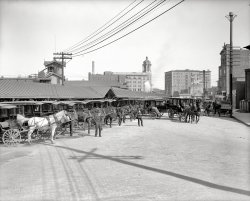
- Miami Beach: 1941
- ... "Raleigh Hotel. Collins Avenue, Miami Beach. Pool, to ocean from balcony. L. Murray Dixon architect." Rustling those palm fronds, the ... Posted by Dave - 01/31/2013 - 1:47pm -
![Miami Beach: 1941 March 5, 1941. "Raleigh Hotel. Collins Avenue, Miami Beach. Pool, to ocean from balcony. L. Murray Dixon architect." Rustling those palm fronds, the winds of war. Large-format acetate negative by Gottscho-Schleisner. View full size.
Only the time line was wrongSolo was right about the ships occasionally being torpedoed off shore -- but only after the war had started. I know: I lived in Fort Lauderdale at the time. Ships heading North would use the Gulf Stream to help them along, so the Krauts knew where they would be. Beaches were patrolled and watch towers were built beachside to track aircraft. Nervous time for all.
Still therehttp://www.raleighhotel.com/explore/the_pool/
Looks very much the same, today! From Bing Aerial View: http://binged.it/WDClE7
Ringside Seats for the Slightly SurrealThough the US was still months from having an active role in WWII when this photo was taken, one could have grabbed a parasol-festooned fruity libation of an evening and watched blazing cargo vessels sinking just a few miles off the beach as German U-boats plied their trade against British shipping.
Actually Not YetSolo's assertion that the patrons of this hotel could watch blazing cargo vessels from the comfort of the pool before the US entry into the war is wrong. For one thing most of the ships carrying cargo and oil from the Gulf ports were American and would join up with the Anglo-Canadian convoys at Halifax or Sydney. Both Hitler and Admiral Donitz who commanded the U-Boat fleet believed that US intervention in World War I had led to the failure of the German submarine blockade of Britain during World War I. They were anxious to keep from provocative incidents that would bring the US into the war, although with US ships convoying merchant vessels in the North Atlantic sometimes made that difficult.
Wide Leg PantsComing of age in the late 90s, there was a ridiculous fad of outlandishly wide-legged jeans, for girls in particular. I didn't realize that the predecessor to that fad could be found with our grandparents (or at least with that woman in the center foreground.)
[Very popular at the time. - tterrace]
(The Gallery, Gottscho-Schleisner, Miami, Swimming)](https://www.shorpy.com/files/images/SHORPY_5a06571u.thumbnail.jpg)
- Tierra del Fuego: 1900
- Circa 1900. "The beach at Old Orchard, Maine -- Ocean Pier and Hotel Velvet." Which, following the curiously inevitable destiny ... Posted by Dave - 11/04/2016 - 11:18pm -
![Tierra del Fuego: 1900 Circa 1900. "The beach at Old Orchard, Maine -- Ocean Pier and Hotel Velvet." Which, following the curiously inevitable destiny of beach resorts surrounded by ashtray-grade sand and literal oceans of water, "burned like oil" in the Great Fire of 1907. 8x10 glass negative, Detroit Publishing Co. View full size.
Re: BathsA cold saltwater bath was probably warmer and more relaxing than bathing in the frigid Maine surf. As for hot baths, I can only wonder what happened to those. Saltwater is very therapeutic, and a hot salt bath sounds most rejuvenating. I wouldn't be surprised if they make a trendy comeback in beachfront spas.
PiersMy guess, based on living in towns that took pride in their piers, is that they were used for fishing. It was also nice to just stroll out to the end of the pier and not jump in.
BathsI bet the "Cold Salt Water Baths" advertised were just a joy to be partake in.
[Hot also available. -tterrace]
Always the same endingSo when did it burn?
[Funny thing about the captions for these photos... - tterrace]
Old Orchard Beach PierHaving spent many summers of my youth in Old Orchard I got to see a few different phases of the Pier. The one that remains there now is only about 5oo feet in length, the original was over 1600 feet long. Like many old beach resorts in the north east the combination of fire and storms are often the merchants of change.
Pier attractionSo many of the pictures of seaside hotels, resorts, etc have long piers extending a long way out to sea. What was the attraction?
the firePhoto here.
Out on a limbThe lady sitting all alone in the foreground, head bowed.
[Those are two women. -tterrace]
(The Gallery, DPC, Swimming)](https://www.shorpy.com/files/images/SHORPY-4a07990a.thumbnail.jpg)
- Pause ... Drink: 1939
- ... A Dr. Kilmer made Swamp Root in Binghamton, NY, along with Ocean Weed and any number of other priceless patent medicines. The company was ... Posted by Dave - 07/22/2012 - 2:46pm -
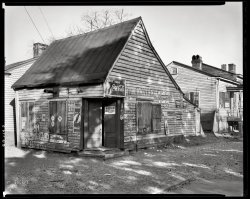
- Networking: 1905
- ... this is a typical scene. The small sailboats dotting the ocean, the wooden summer houses right by the beach, and the weather-beaten, ... Posted by Dave - 08/21/2012 - 12:36pm -
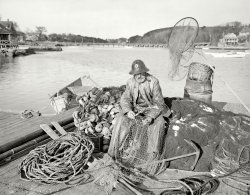
- Stripes and Solids: 1905
- ... b) all bunched together. Nowadays if anyone goes into the ocean, they pretty much keep their distance (unless you are related-and surely ... Posted by Dave - 07/19/2012 - 12:55pm -
![Stripes and Solids: 1905 New Jersey circa 1905. "On the beach at Atlantic City." A lively group seen earlier here. 8x10 inch glass negative, Detroit Publishing Company. View full size.
Gym, tan, laundry.Gym, tan, laundry.
Family TraditionI could weep as I look at this, the life and pleasure of the young who are now all more than 110 years old. This was my grandparents' generation. They loved to visit Atlantic City and 20 years later my father and his three older siblings would be dancing and performing on the Million Dollar Pier, which I believe is pictured here. The stories of my father's boyhood years, summers in Atlantic City, "the playground of the world," and especially the sights and sounds of the Million Dollar Pier, are among my favorites of his. Perhaps like the people pictured here, his family would come by train from Philadelphia (well, they had to cross the river by ferry into Camden and then get the train). The family-- grandmother, uncles, mother and children, would come for the summer, while my grandfather remained in the city, working in the foundry, earning money to keep them there.
[This photo shows the Steeplechase and Steel piers. - Dave]
Shore fast lineMy grandparents would have ranged in age from toddlers to teenagers at this time. They were more likely to have spent summer holidays in Wildwood, though one pair of grandparents rarely missed the Miss America Pageant, which originated at Atlantic City and remained there until it was moved to Las Vegas for reasons that remain a mystery to this writer.
Reading Railroad passengers from Philadelphia took the ferry to Camden's Reading Terminal for trains to Atlantic City but after 1896, Pennsylvania Railroad passengers had the choice of through trains that crossed the Delaware River at the Pennsy's Delair Bridge. Early in the Depression, the joint Pennsylvania Reading Seashore Lines railroad was formed and the Pennsy lost its monopoly on the Delair bridge.
Those women must have been rather uncomfortable in such voluminous bathing costumes.
Anyone?I have never understood why, in these shots of Atlantic City in the early 20th century, seemingly everyone is a) in the water and b) all bunched together. Nowadays if anyone goes into the ocean, they pretty much keep their distance (unless you are related-and surely all these people weren't) Was it just considered the social thing to do then? I am truly curious.
[I'd say it's because of a) hot weather, and b) the sheer quantity of people. - tterrace]
About ten years laterMy grandfather Harry A. Fox (far right in both images) and fellow sailors from the _USS Indiana_ on the beach at Atlantic City in 1918. In the second image they are clowning with some local children.
(The Gallery, Atlantic City, DPC, Swimming)](https://www.shorpy.com/files/images/SHORPY_4a17340a.thumbnail.jpg)
- Incognito: 1942
- ... These days people don't dress up even for a plane or ocean cruise.
Greyhound memories I can remember many scenes like this ... Posted by Dave - 03/28/2013 - 9:53am -
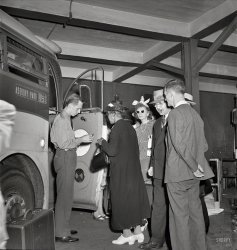
- Thompson's Tug Office: 1908
- ... office and or boats located there. I thought they only had Ocean liners but apparently the sailed the Great Lakes as well.
[There ... Posted by Dave - 06/18/2015 - 2:21pm -
![Thompson's Tug Office: 1908 Port Huron, Michigan, circa 1908. "Steamers at pier." At right, the sidewheeler City of Alpena. 8x10 glass negative, Detroit Publishing Co. View full size.
Fender Bender?I suspect the hanging wooden shapes are fenders, and some have seen hard wear keeping the ships from shattering each others' more delicate upper structure.
Does anyone knowDoes anyone know what those items hanging from the second deck on both ships are for? They look like wooden blanks. Bumpers to protect the ship?
The ship in frontThe ship in front looks like the White Star Lines steamboat Tashmoo which operated between Port Huron and Detroit.
SS City of AlpenaThe City of Alpena is depicted on the 1901 "Fast Lake Navigation" Pan-American Exposition commemorative postage stamp.
Fender BoardsYou see that the dock has large wooden vertical pilings holding the waterside edge up, these give the boat something soft to ride against while docking. When the boat is at a concrete dock face or the concrete lock approaches these fenders protect the hull from abrasion which was important for wooden hulls. Also, they could be used to make up for dock to hull elevation differences.
White Star LineTake a look to the upper left of the photo. There is a sign with a big star on it. In the middle of the star are the letters W S L. If you look closer you can see the star in on a waving flag. This would indicate to me that White Star Lines of Titanic fame had an office and or boats located there. I thought they only had Ocean liners but apparently the sailed the Great Lakes as well.
[There was no connection between Detroit's White Star Line and the British company that operated the Titanic. -tterrace]
1893-1957The City of Alpena was launched along with her sister ship, City of Mackinac, in 1893. In 1921 she was taken off the Coast Line and renamed City of Saugatuck. In 1957 she was scrapped. Info from here.
Detroit and ClevelandI like the Detroit and Cleveland Navigation company logo (D & C) over top of the smokestack. Looks like some pretty fancy metal work.
(The Gallery, Boats & Bridges, DPC)](https://www.shorpy.com/files/images/SHORPY-4a22773a.thumbnail.jpg)
- At the air show
- ... being fired from an F-4 in front of the crowd out over the ocean.
Flying Guppy This Guppy was also flown into Huntsville, Alabama. ... Posted by mhallack - 12/25/2008 - 8:55pm -
![At the air show This was back in 1972 or 1973, that's my dad in the middle, I'm on the left suffering from a headache or needing a V8, my brother on his right. I think this air show was at Point Mugu near Camarillo, California. Or at Van Nuys Airport. Despite my unhappy look I loved these shows as a kid. Can anyone help with what kind of cargo plane that is in the background?
NASA Super GuppyNASA "Super Guppy" transport.
NASA Super GuppyThe Super Guppy, the smaller Guppy, the civilian Stratocruiser and its military counterpart the C-97 were all based on the WWII Boeing B-29 Superfortress bomber. The B-29 had four Wright Cyclone R-3350-R23 turbocharged engines. The early Guppy was equiped with four Pratt & Whitney R-4360's, the Super Guppy is Allison 501-D22C turboprop-powered.
It's a Supper Guppy.It's a Supper Guppy. - Mike
[As opposed to the earlier, less successful Breakfast Guppy. - Dave]
The earlier GuppyThe previous Guppy was the Pregnant Guppy which I saw at the airport in Long Beach, California, sometime shortly after it made its first flight in 1962. Aero Spacelines used surplus KC-97 Stratotankers for the basic building blocks. The PG was really something to see taking off. The Long Beach airport at that time was still a major aviation center and one of the busiest in the world, but today nobody wants an airport in their backyard (so don't buy a house near the airport!)
S-IVB TransportNASA used this plane to transport the third stage of the Saturn V, called the S-IVB, from the plant to the Cape. It was the only stage small enough to be flown - the first and second stages were moved by barge.
StingerThe Formula 1 racer in the foreground looks like Art Williams's "Stinger" race plane. It would have been only about a year old at the time the photo was taken. Pretty sure it is in a museum now. I think its last racer-owner was astronaut Deke Slayton.
More InfoMore info on The Stinger (and a strange tale featuring Deke Slayton's ghost) can be found here.
I was there too!Yes, it was either 1972 or 1973. A bunch of us from Northrop Tech in Inglewood drove out to that show. I clearly remember the F-14 parked next to the Guppy, it was the first time I had seen both aircraft in person. There was a live fire display at the show, with missiles being fired from an F-4 in front of the crowd out over the ocean.
Flying GuppyThis Guppy was also flown into Huntsville, Alabama. It flew the Instrument Unit built by IBM to the Cape. It was a real sight to see it take off. You'd think it wasn't going to make it.
(ShorpyBlog, Member Gallery)](https://www.shorpy.com/files/images/image0_0.thumbnail.jpg)
- PBY Blister Gunner: 1942
- ... Adrian Marks disobeyed standing orders not to land in open ocean, and rendered the craft unflyable, but ultimately saved the lives of ... Posted by Dave - 08/05/2012 - 10:55am -
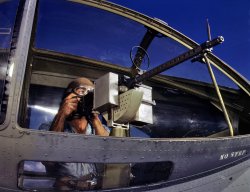
- Clark's Corner: 1937
- ... River and about 8 miles from Cocoa Beach and the Atlantic Ocean. - Ken]
Pop. 120 As described in Florida: A Guide to the ... Posted by Dave - 02/13/2014 - 5:47pm -
![Clark's Corner: 1937 January 1937. Brevard County, Florida. "Roadstand near Cocoa." Photo by Arthur Rothstein for the Farm Security Administration. View full size.
Cocoa Beach!Just wait another thirty years, give or take. A bottle will wash up on the shore, to be discovered by an astronaut on a training exercise.
[No bottles will be washing up in Cocoa, which is on the Indian River and about 8 miles from Cocoa Beach and the Atlantic Ocean. - Ken]
Pop. 120As described in Florida: A Guide to the Southernmost State (Federal Writers' Project, 1939):
"INDIAN RIVER CITY, 50.9m (19 alt., 120 pop.) formerly called Clark's Corner, consists of a few stucco houses, filling stations, and a post office, overlooking the broad reaches of the river. Indian River City is at the junction with State 22 (see Tour 9).
South of Indian River City dense growths of palms and pines flank U.S. 1; palmetto thickets and low green shrubbery add to the beauty of the water views."
In Color!Corner of (now) SR50 and US1. Postcard from the State Archives of Florida, (Florida Memory).
I HAD to look it upa TEMPLE is a bright orange red colored fruit, oval shaped, easy to peel and a cross between an orange and a tangerine, it has lots of seeds and a bitter orange flesh under the skin.
TitusvilleThis stand was about 20 minutes away from Cocoa and 30 miles from Cocoa Beach. The corner is in Titusville (I live within walking distance of it). Indian River City was consolidated with Titusville back in the 60's. Today if you look across that river you can see Kennedy Space Center. There is nothing left of the buildings in the post card. It's now a busy intersection with a Walgreens and a gas station.
The temple orangeThe temple orange originated in Winter Park Florida, developed by Louis Hakes and named after W. C. Temple, both residents of Winter Park. There's a Temple Drive and Temple Trail in Winter Park, the latter leading into the neighborhood in which I grew up.
(The Gallery, Arthur Rothstein, Eateries & Bars, Florida, Stores & Markets)](https://www.shorpy.com/files/images/SHORPY_8b28486a.thumbnail.jpg)
- Bien Venido: 1897
- ... this photograph is looking generally southeast with the ocean way out beyond Anastasia Island where the Lighthouse stands. The waterway ... Posted by Dave - 07/18/2012 - 7:06pm -
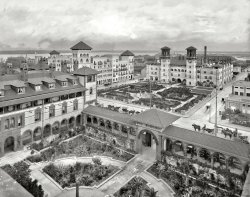
- Gingerbread Hotel: 1904
- ... Velvet, Old Orchard, Maine." The seaside resort and its ocean pier. Three years later, in a denouement that Shorpyites can recite in ... Posted by Dave - 11/02/2015 - 8:19pm -
![Gingerbread Hotel: 1904 1904. "Hotel Velvet, Old Orchard, Maine." The seaside resort and its ocean pier. Three years later, in a denouement that Shorpyites can recite in their sleep, the place burned to the ground. 8x10 inch glass negative. View full size.
Added information of the fire.The great fire of 1907 actually burned the entire beachfront including this hotel.
http://www.harmonmuseum.org/local-history
Is he riding a giant pickle?or is that some other native flora from Maine?
[Mr. Peanutine. - Dave]
It's a giant peanutI can't find much about Peanutine on the interwebs, but it appears to have been a peanut confection sold in Maine from these charming peanut-shaped donkey carts in the early part of the 20th century.
We Sell Peanutine from this Wagonhttp://digitalcommons.library.umaine.edu/spec_photos/766/
History Repeats itselfWe were there on vacation on July 19, 1969 when the pier burnt.
Golly, what a nice day.A mile of balcony and nobody sitting outside.
Lousy fires. I have a strong feeling that most of these old structures would have been torn down regardless. Most unfortunate because they truly are wonderful buildings.
(The Gallery, DPC)](https://www.shorpy.com/files/images/SHORPY-4a12172a.thumbnail.jpg)
- Bleak House: 1901
- ... "The Boardwalk and Auditorium Pier, Atlantic City." At Ocean Avenue, George Coryell's Bleak House hotel. View full size.
The ... Posted by Dave - 01/03/2019 - 11:06am -
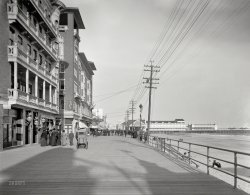
- Radio Highlights: 1957
- ... ascent to over 100,000 feet, blood cell research, and deep ocean exploration.”
WTOP “20th Century: Vertijets” examines the ... Posted by Dave - 06/02/2017 - 12:50pm -
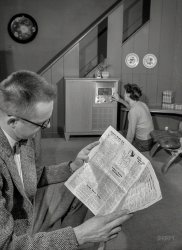
- Pony Boys: 1905
- ... the sun sets such that shadows grow long toward the ocean. As autumn nears, the setting sun seems to almost set in the south on ... Posted by Dave - 08/13/2012 - 6:56pm -
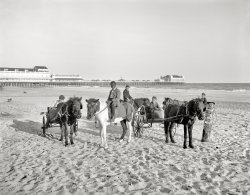
- Great Southern: 1906
- ...
This picture makes me want a room facing the East, ocean view please.
Gone but Not Forgotten... I grew up on the ... Posted by Dave - 08/03/2012 - 10:19am -
![Great Southern: 1906 Gulfport, Mississippi, circa 1906. "Great Southern Hotel." Built 1902-03; demolished in 1951. Panorama of three 8x10 glass negatives. View full size.
People count I count 9.... two on each of the "wing" porches or entries, the two on the right, one on same side just behind the building, somewhat blurred.... The ladder man, the seated man, and one in the window to the seated man's left, ground floor.Several geese and a dog!
Next pleaseI hope the library will eventually yield to us a view of what's holding up all those masts just barely visible on the opposite side of the hotel.
[Possibly some of these out in the harbor, from a shot made around the same time. - tterrace]
I wish Shorpy's was a time machineI would pick a picture and be transported, at least for a little while. I wouldn't like to be the man on that ladder, though.
Eight and countingI see seven people without to "maybe" person in the carriage: two walking on the right side of the hotel, two lounging on the right porch, two on the left porch, the ladder man and one on the far left covered walkway. Are there more?
There's just one word for this photo......"Spectacular!"
A Fine Southern HostelryI don't know how exceptional the fire proofing of this hotel was for the time but it appears to have paid off. A somewhat-rare example of an old hotel on Shorpy not lost to fire but to the wrecker.
The St. Louis Lumberman, January 1910.
A Fine Southern Hostelry.
We present a picture herewith of a hotel of which it has been well said that it is “fit for a king; good enough for a commoner.” Our reference is to the Great Southern Hotel at Gulfport, Miss., a splendid bit of architectural designing and a fine example of comfortable, if not luxurious, furnishing. This well-known hostelry fronts beautifully on the Gulf of Mexico over a space of 350 feet, is three stories high and has 250 guest chambers. Two wings of the building extend backward to a park, cared for by a landscape gardener.
Though a frame structure, such ample precautions against fire have been taken in its designing and construction as to practically do away with fire risk, The roofing is tile; the floors are double, with asbestos between each floor; the lathing is steel wire, and cement plastering has been used throughout the building. The house being heated by steam and lighted by electricity, no lamp is used in any part of it, and no fire of any character in any exposed position. In addition to these safeguards, the heating and cooking plants are segregated; there are standpipes on all floors, and an organized and well-drilled fire brigade is ready for service at almost a moment’s notice. The supply of water comes from a well 850 feet deep, and according to a chemist has curative properties for rheumatism and for kidney and other troubles.
Every guest chamber is equipped with a private telephone, hot and cold water and a private bath. The lobby and parlors are spacious and elegant. and the sun parlor fronts the sea. The large dining room is finished in Flemish oak, and looks out upon the Sound. The cuisine is directed by a chef who is famous for his productions, and the larder is stocked with the markets’ choicest products, including seafoods and luscious fruits.
The climate around Gulfport is a delightful one in winter, and there are many outdoor amusements to which the visitor can turn his hand, including fishing and boating. One can hardly find a more ideal place to spend a winter vacation than at and around Gulfport.
7 Humans?I can spot 6 people for sure. But is that a person in the horse drawn carriage or some other object?
This picture makes me want a room facing the East, ocean view please.
Gone but Not Forgotten...I grew up on the Mississippi Gulf Coast and although the
Great Southern was torn down a year after I was born, there are still those down there to this day who speak of it in hushed tones (they're getting fewer and further between!). US Highway 49 runs east and west about where the south side of the building is in the picture and
the gravel road on the left side of the picture is now the main street of downtown Gulfport, 25th Avenue and also US Highway 49. When the hotel was torn down in the early 1950's, the developers built an entire block of "modern" commercial buildings that housed chain stores like Learners and TG&Y and some local businesses. All of these buildings were devastated in 2005 by Hurricane Katrina. After the hurricane, they leveled all the debris and the site was a vacant lot. Interestingly, the smokestack on the right side of the picture was the edge of the Great Southern power plant. Although modified, it still stands and up until the early 1990's was a Ford dealership for many years.
For any of those who want to colorize, the building was a deep green with white trim. It had a red terra cotta tile roof. This picture was taken shortly after it was built, but after several years, the grounds of the Great Southern were covered with lush vegatation -- azaleas, palms, live oak with fountains (pictured here) on both sides of the building. The water in front of the hotel is the Mississippi Sound, which opens into the Gulf of Mexico. Those tall ship masts you see right behind the hotel are at the fledgling Port of Gulfport, which had only been established around ten years earlier, thus the name of the city "Gulf Port". As homage to the past,
a local bank built a new office tower in the 1980's about two blocks from this site and established a members only private club on the top floor, which is called The Great Southern Club.
(Panoramas, DPC)](https://www.shorpy.com/files/images/SHORPY_Gulfport_Panorama.thumbnail.jpg)
- Over the River: 1905
- ... "barge captain" in charge.
In these days of sealed ocean shipping containers which are trans-loaded only as a unit, it's difficult ... Posted by Dave - 02/23/2017 - 1:27pm -
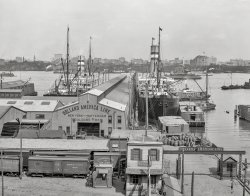
- Luggage Lugged: 1936
- ... of the oncoming war, they would be as anachronistic as an ocean liner today.
Trunks When I moved halfway across the country in ... Posted by Dave - 07/01/2020 - 3:16pm -
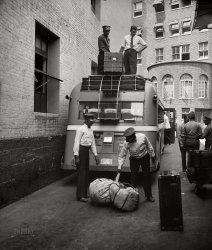
- Nice Tie: 1941
- ... naval installation was 35 miles away and nowhere near an ocean.
High-speed Crane The Crane Naval Depot still exists along with ... Posted by Dave - 06/12/2020 - 1:56pm -
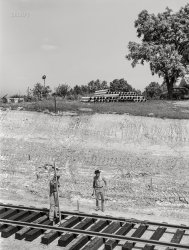
- Old North Bridge: 1910
- ...
to keep the past upon its throne
Unheard beyond the ocean's tide,
Their Mother England made her moan."
I have always been ... Posted by Dave - 07/10/2015 - 11:42am -
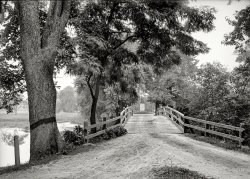
- The Continental: 1902
- ... period must have been insuring Hotels against fire. Wood, ocean breeze,and enclosed groups of people were apparently not a good idea.
... Posted by Dave - 05/17/2014 - 11:35pm -
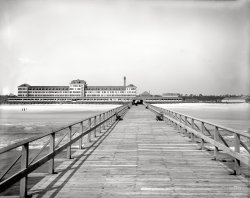
- Wartime Rail: 1942
- ... the fullest efficiency and speed. Loss and diversion of ocean carriers which served our seaboard cities have thrown an enormous burden ... Posted by Dave - 12/29/2017 - 12:06pm -
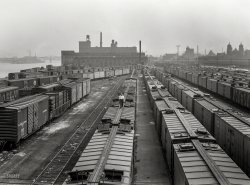
- Eat Velvet: 1900
- ... circa 1900. "The beach at Old Orchard -- Hotel Velvet and Ocean Pier." The roof of whose "Big Casino" urges us to "Eat Velvet, Drink ... Posted by Dave - 08/03/2018 - 1:42pm -
![Eat Velvet: 1900 The Maine shore circa 1900. "The beach at Old Orchard -- Hotel Velvet and Ocean Pier." The roof of whose "Big Casino" urges us to "Eat Velvet, Drink Moxie." Panorama made from three 8x10 glass negatives. View full size.
Wait, wait, don't tell me.The hotel's basement was known as "The Velvet Underground," right?
Current Day
A lot shorter now.Winter storms and fires have taken their toll. The pier was built in 1898. The original length was 1,825 feet. It lost a few hundred feet the first winter it faced. The large casino at the end used to host big band music during its heyday. I remember in the 1960s there were many photos of the famous bands hanging on the walls. At that time the casino building housed a miniature golf on the first floor and a small Aquarium on the second floor. The casino building itself collapsed into the sea in the famous Blizzard of 1978.
The pier now is under 600 feet in length and at low tide is often completely out of the water.
More on its history here http://www.oobpier.com/history.html
Yet another flaming emberThis may come as a surprise. The Hotel Velvet burned down on August 15, 1907.
All about the slopeOne needn't look too close to see the difference between Atlantic and Pacific beaches with this photo. The Atlantic beaches feature more gradual sloping, which produce larger tidal shifts and warmer/shallower swimming waters, while Pacific (think Santa Monica, etc.) beaches have colder waters, bigger surf, and fewer storms. There's more at play, of course.
Velvet Ice Cream?http://bid.grandeestateauctions.com/VINTAGE-VELVET-ICE-CREAM-METAL-SIGN_...
[The Velvet Kind, a popular ice cream brand around the turn of the century, has made multiple cameos here on Shorpy. -Dave]
(Panoramas, DPC, Swimming)](https://www.shorpy.com/files/images/SHORPY_Old_Orchard_Panorama_1.thumbnail.jpg)
- Naval Gazers: 1943
- ... before taking off on a patrol flight over the Atlantic Ocean." 4x5 nitrate negative, Office of War Information. View full size.
... Posted by Dave - 06/15/2016 - 1:03am -
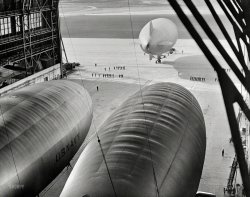
- Gray Gardens: 1911
- ... The dinning-room is so constructed that a full view of the ocean may be had from every table. The bedrooms are so arranged that a suite of ... Posted by Dave - 08/02/2012 - 7:40pm -
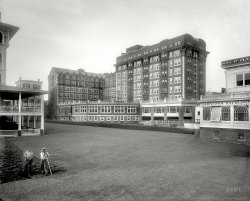
- Sailing on the Sand: 1903
- ... 100 years ago than now. We walked on the beach and in the ocean while there. The beach is much narrower now, even at low tide and they ... Posted by Dave - 10/15/2012 - 9:26am -
![Sailing on the Sand: 1903 Circa 1903. "Sailing on the beach at Ormond, Florida." An interesting looking character at the controls. 8x10 glass negative, Detroit Publishing. View full size.
Major Hoople Au Bord de la MerA fez and a wool suit, Florida weather -- and Arrid won't be invented for a few years yet. The pilot looks as if he's calculating whether he can run over the photographer before the latter can gather up his tripod-mounted view camera and skedaddle (they still did that back then).
[Our captain would be bundled up against the chill -- Florida was a winter resort. -Dave]
In the Midwestthet thar is known as a "prairie schooner."
Boat For HireIt appears that one could buy rides on that contraption. Similar to the present day's hang gliders. In the background we see a couple of bicycle people movers.
Appropriate PhotoI just returned from my 50th High School Reunion in Daytona Beach (on the south edge of Ormond Beach for those that don't know). Everything is a lot different now than it was back then although I think it was better 100 years ago than now. We walked on the beach and in the ocean while there. The beach is much narrower now, even at low tide and they now charge a fee to drive on the sand. Great photo and I have enjoyed this one and the other photos of Daytona Beach shown on this site. They bring back memories of a time that will never come again. Thanks a lot.
(The Gallery, Boats & Bridges, DPC, Florida)](https://www.shorpy.com/files/images/SHORPY_4a10867a.thumbnail.jpg)
- Brighton Beach: 1903
- ... ahead of her on the boardwalk.
Moving Day The ocean was eroding the beach, and was almost lapping at the front porch. In a ... Posted by Dave - 04/24/2019 - 12:01am -
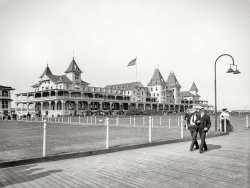
- Life on the high sea
- ... sheltered locations where they didn't have to deal with ocean storm waves. Their real nemesis (besides the USCG, which tended to remove ... Posted by Samuel1940 - 09/20/2011 - 8:50pm -
![Life on the high sea Location: Unknown. Date: Unknown. This home appears to be a true light house. One can imagine it didn't last many storms. View full size.
A Screw-Pile LightThis is an example of a screw-pile lighthouse, of which indeed only a few remain. The did indeed screw the pilings into the bottom. They were particularly popular in the Chesapeake Bay region, but they saw use in NC and along the gulf coast too, and there are a number of monster versions along the Florida coast.
They were actually pretty tough in the face of storms, particularly since they were mostly used in more sheltered locations where they didn't have to deal with ocean storm waves. Their real nemesis (besides the USCG, which tended to remove the house once they became automated) was ice, which would ride up the piles and push the house off the foundation. There were several instances in which the house ended up being carried down the bay, occupants and all.
I can't identify this particular light with any certainty, but it might be the Lower Cedar Point Light on the lower Potomac River.
Croatan Shoal Light, NCIt's the Croatan Shoal light in North Carolina. Click for info.
I know you saidit was waterfront property but this is rediculas.
[We used to summer at Rediculas. - Dave]
(ShorpyBlog, Member Gallery)](https://www.shorpy.com/files/images/waterhouseunknown.thumbnail.jpg)























